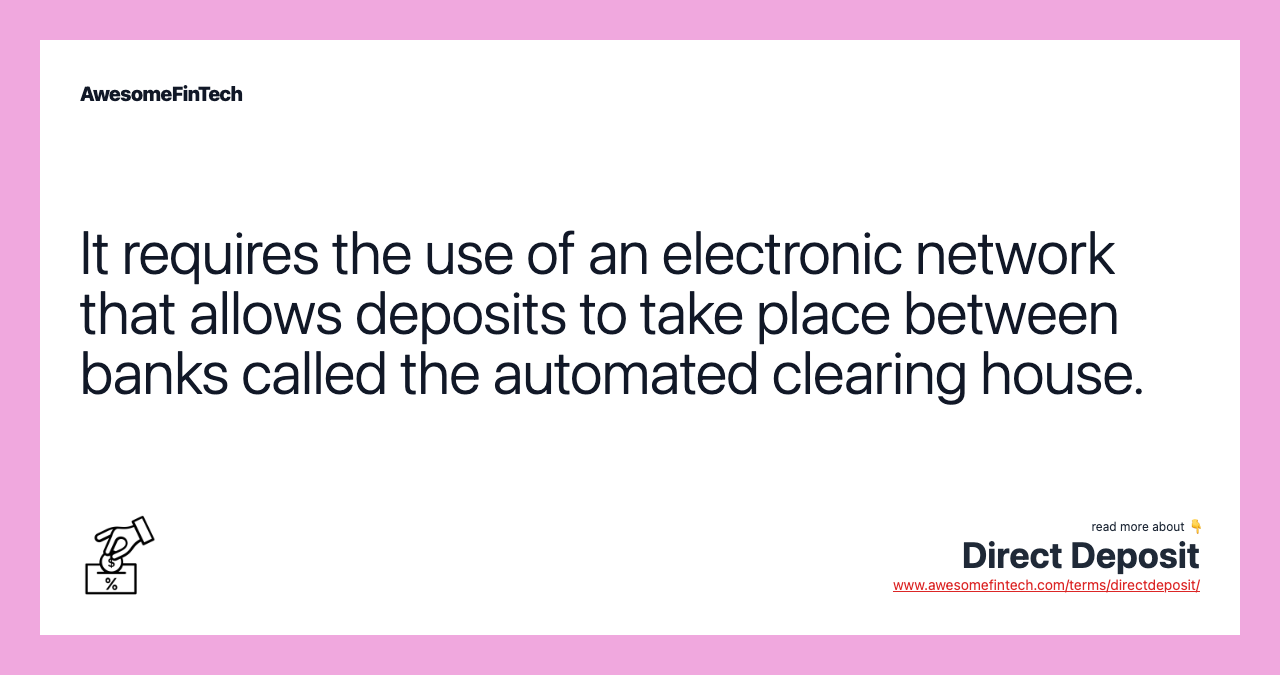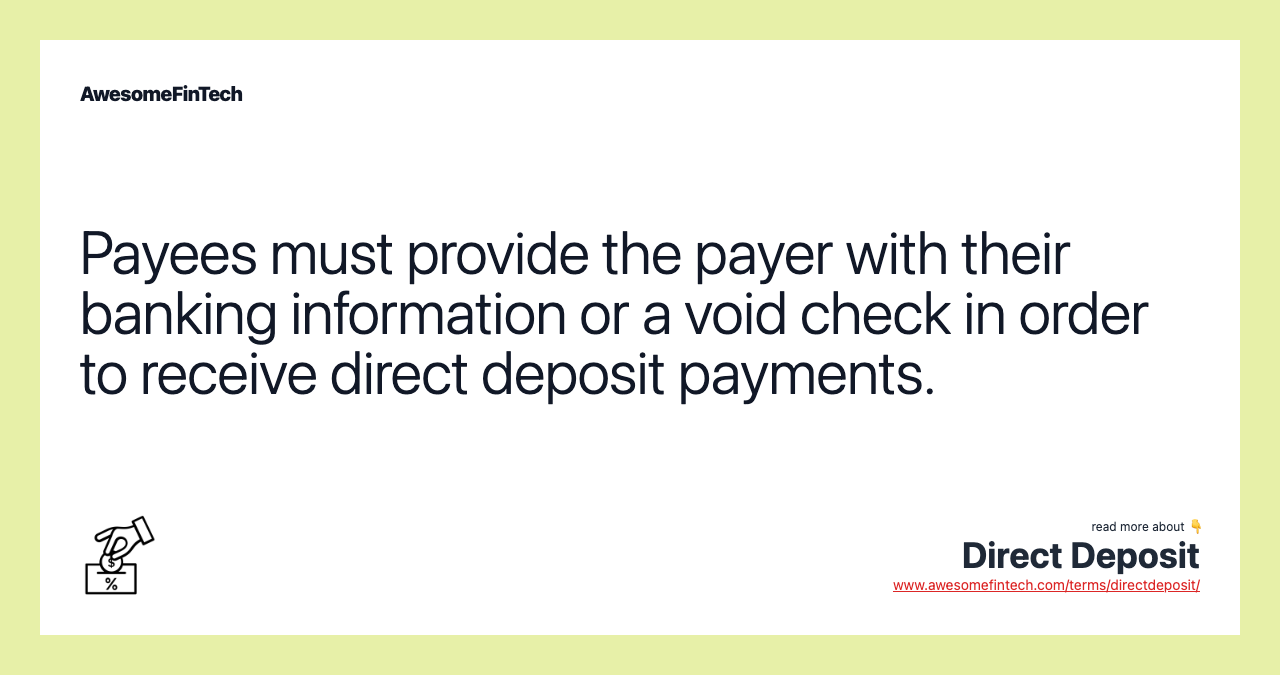Direct Deposit
The term direct deposit refers to the deposit of funds electronically into a bank account rather than through a physical, paper check. Types of cybersecurity attacks on sensitive financial information include: Backdoor attacks in which thieves exploit alternate methods of accessing a database that doesn't require traditional authentication Denial-of-service attacks, which prevent a rightful user from accessing a system often by entering a wrong password enough times that the account is locked Direct-access attacks including bugs and viruses, which gain access to a system and copy its information Measures to increase security can include using a password protector and/or choosing more complicated passwords, with a combination of letters, numbers, capitals, and special signs, to encrypt personal financial data. The term direct deposit refers to the deposit of funds electronically into a bank account rather than through a physical, paper check. Direct deposit is the deposit of funds electronically into a bank account rather than through a physical, paper check. In order for the funds to be transferred from the payer, the recipient must provide the name of their bank, their account number, and the bank's routing number to the person or business making the deposit.

What Is Direct Deposit?
The term direct deposit refers to the deposit of funds electronically into a bank account rather than through a physical, paper check. Direct deposit requires the use of an electronic network that allows deposits to take place between banks. This network is called the automated clearing house (ACH). Because the funds are transferred electronically, recipients' accounts are credited automatically, so there is no need to wait for the money to clear. Common uses for direct deposit include paychecks, tax refunds, and other benefits.




How Direct Deposit Works
Direct deposit is a safe and convenient way to receive payment. Funds are deposited into a recipient's account directly through an electronic network. In order for the funds to be transferred from the payer, the recipient must provide the name of their bank, their account number, and the bank's routing number to the person or business making the deposit. Alternatively, they may provide a void check which has the same information printed on it.
It can take a few days for direct deposit to be set up. Once the depositor has the information, they enter it into their banking system. Funds are transferred electronically and are deposited into the recipient's account at midnight on the payment date. Since the funds clear automatically through the ACH, they are available immediately, so there's no need for the bank to put a hold on them.
This method is commonly used to transfer an employee's salary, tax refunds, investment redemptions, payments from retirement accounts, and government benefits like Social Security. Bill payments are also made using direct deposit from debtors to creditors. For instance, taxpayers have the option to receive their refunds in the form of a personal check or through a direct deposit. Most refunds are issued within a few weeks of the date the taxpayer initially filed their annual income tax. Direct deposit allows the government to make the refund immediately available to the citizen. The same applies to government benefits like Social Security.
While most direct deposits are done using bank accounts and automated clearing houses, these payments can also be done using online banking and by transfers through smartphones. If, for instance, someone wants to send money directly to a family member, all they need is the person's email and/or mobile phone number. The recipient gives the transfer company their banking information. Once the money is sent, it deposits the money into the payee's account. As with other direct deposit cases, the money is available for immediate use.
Special Considerations
Direct deposit is a popular and convenient way for people to send and receive payment. For payers, it cuts down any expenses related to check-writing, postage, and administration. For payees or recipients, it eliminates the risk of losing a physical check along with the need to visit a bank in person to make a deposit. As mentioned above, direct deposit recipients are not subject to a check clearing wait period — salaries paid via check can often take a week or more to clear within their account.
Not everyone has a bank account. If the payer is required to provide a form of electronic payment like direct deposit, they may be able to provide funds in another way such as a prepaid debit card. This often occurs in cases where the government sends cards to benefit recipients who don't bank with traditional financial institutions.
Payers who are required to make electronic payments may provide recipients with prepaid debit cards.
Disadvantages of Direct Deposit
Direct deposit and other forms of electronic banking come with greater efficiency, along with a greater risk of online security hacks. The rise of certain cybersecurity measures to help protect forms of banking, such as direct deposits, has been critical. Types of cybersecurity attacks on sensitive financial information include:
Measures to increase security can include using a password protector and/or choosing more complicated passwords, with a combination of letters, numbers, capitals, and special signs, to encrypt personal financial data.
Related terms:
Automated Clearing House (ACH)
The Automated Clearing House Network (ACH) is an electronic funds-transfer system run by NACHA, formerly the National Automated Clearing House Association. read more
Check Hold
A check hold denotes the maximum number of days that a bank can legally hold the money from a deposited check. read more
Check
A check is a written, dated, and signed instrument that contains an unconditional order directing a bank to pay a definite sum of money to a payee. read more
Checking Account
A checking account is a deposit account held at a financial institution that allows deposits and withdrawals. Checking accounts are very liquid and can be accessed using checks, automated teller machines, and electronic debits, among other methods. read more
Clearing
Clearing is when an organization acts as an intermediary to reconcile orders between transacting parties. A clearing bank approves checks for payments. read more
Cybersecurity
Cybersecurity refers to the measures taken to keep electronic information, as well as hardware and software, private and safe from damage or theft. read more
Deposit
A deposit is both a transfer of funds to another party for safekeeping and the portion of funds used as collateral for the delivery of a good. read more
Encryption
Encryption is a means of securing digital data using an algorithm and a key. read more
Online Banking
Online banking allows a user to conduct financial transactions via the Internet. Online banking is also known as Internet banking or web banking. read more
Pay to Order
Pay to order refers to negotiable checks or drafts paid via an endorsement that identifies a person or organization the payer authorizes to receive money. read more